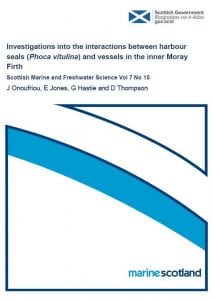Marine
How do seals interact with shipping vessels?
October 17, 2016 by Marine Scotland Communications No Comments | Category Collaborations, Marine Directorate Science, Scottish Marine and Freshwater Science report series
 As shipping activity continues to increase around the world, understanding the way that marine mammals interact with vessels is of particular importance. Such concerns generally relate to potential harmful effects of increased shipping noise on marine mammals and the potential for physical injury due to collisions. This is a particular issue for harbour seals (Phoca vitulina) whose populations have experienced significant local declines in Scottish waters.
As shipping activity continues to increase around the world, understanding the way that marine mammals interact with vessels is of particular importance. Such concerns generally relate to potential harmful effects of increased shipping noise on marine mammals and the potential for physical injury due to collisions. This is a particular issue for harbour seals (Phoca vitulina) whose populations have experienced significant local declines in Scottish waters.
To understand how harbour seals interact with vessels, a telemetry-based study of the swimming behaviour of seals was carried out in the Moray Firth to compare seal and vessel movements with the purpose of identifying potential areas with high spatial overlap. The study also provided data on seal movements between haulout areas, to identify connectivity between seal haulout sites in the Dornoch Firth Special Area of Conservation (SAC) and potential areas of construction in the inner Moray Firth. To meet the project aims, 37 GPS tags were deployed on harbour seals at two different sites at Ardersier and in the Dornoch Firth during the two year study in 2014/15.
Main findings
- The inner Moray Firth showed comparatively low seal-vessel co-occurrence rates, in comparison to previous estimates of seal-shipping spatial overlap throughout the UK. Offshore sites also showed comparatively low co-occurrence rates even in areas with high levels of shipping traffic.
- There does not appear to be any obvious relationship between incidences of strandings of spiral lacerated seals and areas where seal-shipping overlap is high.
- Observations of movements of individual seals and vessels did not show any apparent responses; seals did not appear to react to close passing vessels; they neither moved towards nor away from them. The research was commissioned by Marine Scotland and undertaken by the Sea Mammal Research Unit, University of St Andrews.
Further Information
Tags: Dornoch Firth, Moray Firth, seals


Leave a comment